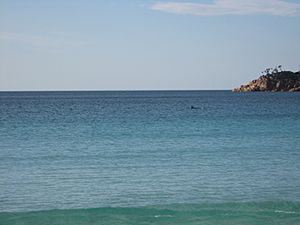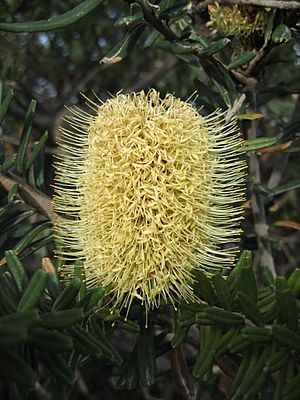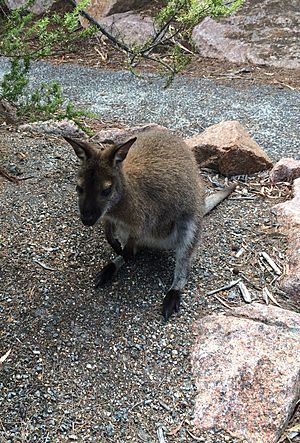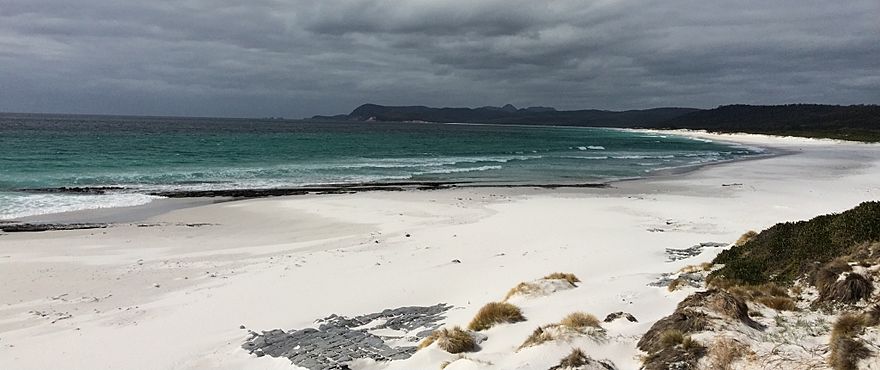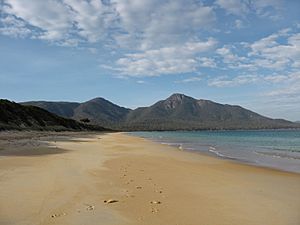Freycinet National Park facts for kids
Quick facts for kids Freycinet National ParkTasmania |
|
|---|---|
|
IUCN Category II (National Park)
|
|

Wineglass Bay
|
|
| Nearest town or city | Coles Bay |
| Established | 1916 |
| Area | 169 km2 (65.3 sq mi) |
| Visitation | 200,000 (in 2008) |
| Managing authorities | Tasmania Parks and Wildlife Service |
| Website | Freycinet National Park |
| See also | Protected areas of Tasmania |
Freycinet National Park is a special place on Tasmania's east coast in Australia. It's about 125 kilometers northeast of Hobart. This park covers a big part of the Freycinet Peninsula, which was named after a French explorer, Louis de Freycinet. It also includes Schouten Island.
Freycinet National Park was created in 1916. This makes it one of Tasmania's oldest parks, along with Mount Field National Park. The small town of Coles Bay is right next to the park. The bigger town of Swansea is also nearby.
The park is famous for its beautiful, rugged coastline. It has a hidden spot called Wineglass Bay, which is very popular. You'll also see amazing red and pink granite rocks here. A line of jagged granite peaks, known as "The Hazards", stands out against the sky.
Freycinet National Park is very important for nature. It protects many rare plants and animals that are only found in Tasmania. The park also has different types of landscapes and natural communities. It's a key place for keeping these species safe.
The park is also important for its history. It protects many sites from Aboriginal and European history. However, more research is needed to fully understand the human story of the park. Large parts of Freycinet remain untouched by people. This includes some of its water sources and natural areas.
Many people visit Freycinet National Park each year. Tourism is a big part of the economy for eastern Tasmania. Visitors love the park's natural beauty, good weather, and fun activities. Thousands of people come to enjoy the coast and the peaceful, isolated setting.
Contents
Park Geology: Rocks and Mountains
The main type of rock you'll find at Freycinet is granite. This granite formed during a time called the Devonian period. A pink mineral called Orthoclase gives the mountains and coastline their special pink color. You can also see black micas and white quartz rocks. The western side of Schouten Island has a different type of rock called dolerite.
Park Ecology: Plants and Animals
Freycinet National Park is home to 49 species that are found only in Tasmania. This makes it a very special place for unique wildlife.
Many mammals live here. These include the brushtail possum, ringtail possum, and sugar glider. You might also spot echidnas, wombats, and different types of small mice and rats. The Tasmanian bettong and long-nosed potoroo also call this park home.
Sadly, the Tasmanian devil population has dropped a lot here. This is because of a disease called devil facial tumor disease. Large ocean animals like southern right whales, humpback whales, and bottlenose dolphins visit the bay. They come to feed, have their babies, or rest.
Flora: The Plants of Freycinet
The plants in Freycinet National Park show how the temperature and rain affect the area. Most of the park has dry forests and woodlands. You'll see black peppermint trees (Eucalyptus amygdalina). Underneath these trees, there are many types of heath plants. These include Banksia species, Leptospermum species, and Melaleuca species.
Near Hazards Lagoon, you'll find thick coastal scrub. This includes Acacia longifolia and a dense forest of Allocasuarina verticillata. To the east, Eucalyptus ovata and Eucalyptus obliqua trees are common.
More than 500 different plant types have been found in the park. Over 80 of these are orchids. Some plant species are very rare and only grow in small areas. Many, like Melaleuca pustulata and Epacris barbata, are protected by Tasmania's Threatened Species Protection Act 1995.
Fauna: The Animals of Freycinet
Mammals of Freycinet
The red-necked wallaby, also known as Bennett's wallaby (Macropus rufogriseus), is often seen in the park. They like to eat low-growing plants like grass. They are also known to gather near people.
Another common animal is the eastern quoll (Dasyurus viverrinus). This marsupial carnivore used to live on mainland Australia but is now only found in Tasmania. The Tasmanian pademelon (Thylogale billardierii) is also common here. However, you'll rarely see them during the day as they come out at night to feed.
Echidnas (Tachyglossus aculeatus) can be seen during the day. They search for ants and other food in the forest floor or coastal plants. The eastern pygmy possum (Cercartetus nanus) and the little pygmy possum (Cercartetus lepidus) are rare to spot. They are listed as vulnerable in some parts of Australia but not in Tasmania.
The New Holland mouse (Pseudomys novaehollandiae) is an endangered species in Tasmania. It is rare, but it does live within Freycinet National Park.
Reptiles and Amphibians of Freycinet
Freycinet National Park is home to many reptiles. These include different types of lizards, skinks, and snakes. The ocellated skink (Niveoscincus ocellatus), Tasmanian tree skink (Niveoscincus pretiosus), and she-oak skink (Cyclodomorphus casuarinae) are all unique to Tasmania and live in the park.
Other reptiles you might find are the blotched blue-tongued lizard (Tiliqua nigrolutea) and the mountain dragon (Rankinia diemensis). The lowland copperhead snake (Austrelaps superbus) also lives here.
Several amphibians live in Freycinet. The Tasmanian froglet (Ranidella tasmaniensis) is unique to Tasmania and can be seen in creeks. The common eastern froglet (Crinia signifera) is often found in wet areas like swamps. Other frogs include the southern toadlet (Pseudophryne semimarmorata) and the spotted grass frog (Limnodynastes tasmaniensis). You might also see the southern brown tree frog (Litoria ewingii) and the growling grass frog (Litoria raniformis).
Birds of Freycinet
Because Freycinet has many different natural areas, lots of bird species live or pass through the park. You can see large birds of prey like the brown falcon (Falco berigora) and the white-bellied sea eagle (Haliaeetus leucogaster).
Smaller birds include the superb fairy-wren (Malurus cyaneus) and the flame robin (Petroica phoenicea). Several bird species in the park are protected by the TSP Act. These include the black-browed albatross (Thalassarche melanophris) and the shy albatross (Thalassarche cauta).
The Tasmanian wedge-tailed eagle (Aquila audax fleayi) and the white-fronted tern (Sterna striata) are also protected. Other protected birds are the Australian fairy tern (Sternula nereis) and the swift parrot (Lathamus discolor). The endangered swift parrot breeds on Tasmania's east coast from September to January. They follow the flowering of certain Eucalyptus trees before flying to mainland Australia for winter.
Park Climate: Weather in Freycinet
The park gets about 600 millimeters (23.6 inches) of rain each year. The climate here is similar to that of France. It enjoys more than 300 days of sunshine on average.
| Climate data for Friendly Beaches | |||||||||||||
|---|---|---|---|---|---|---|---|---|---|---|---|---|---|
| Month | Jan | Feb | Mar | Apr | May | Jun | Jul | Aug | Sep | Oct | Nov | Dec | Year |
| Record high °C (°F) | 36.4 (97.5) |
37.0 (98.6) |
37.0 (98.6) |
31.4 (88.5) |
24.0 (75.2) |
21.0 (69.8) |
19.0 (66.2) |
23.5 (74.3) |
27.0 (80.6) |
32.7 (90.9) |
35.0 (95.0) |
37.0 (98.6) |
37.0 (98.6) |
| Mean daily maximum °C (°F) | 22.8 (73.0) |
22.6 (72.7) |
21.4 (70.5) |
18.6 (65.5) |
16.1 (61.0) |
14.1 (57.4) |
13.7 (56.7) |
14.7 (58.5) |
16.7 (62.1) |
18.0 (64.4) |
19.5 (67.1) |
21.8 (71.2) |
18.3 (64.9) |
| Mean daily minimum °C (°F) | 13.1 (55.6) |
13.2 (55.8) |
11.8 (53.2) |
9.6 (49.3) |
8.3 (46.9) |
6.4 (43.5) |
5.7 (42.3) |
6.1 (43.0) |
7.5 (45.5) |
8.6 (47.5) |
10.0 (50.0) |
11.6 (52.9) |
9.3 (48.7) |
| Record low °C (°F) | 6.0 (42.8) |
7.2 (45.0) |
5.3 (41.5) |
1.0 (33.8) |
−1.1 (30.0) |
0.0 (32.0) |
−0.5 (31.1) |
−0.1 (31.8) |
1.2 (34.2) |
1.2 (34.2) |
3.0 (37.4) |
5.5 (41.9) |
−1.1 (30.0) |
| Average precipitation mm (inches) | 61.2 (2.41) |
60.3 (2.37) |
53.7 (2.11) |
50.3 (1.98) |
47.0 (1.85) |
36.2 (1.43) |
48.5 (1.91) |
48.7 (1.92) |
33.3 (1.31) |
65.2 (2.57) |
58.8 (2.31) |
36.6 (1.44) |
601.7 (23.69) |
| Source: Bureau of Meteorology | |||||||||||||
Environmental Threats to Freycinet
Many things threaten the plants and animals in Freycinet National Park. As more people visit natural areas, it can put extra stress on species that are already struggling. Building and maintaining roads, paths, lookouts, and places to stay can have many impacts.
For example, a study found that Tasmanian devils and eastern quolls are more likely to be hit by cars. This happens after roads are improved to handle more tourist traffic.
Activities like bushwalking and horse riding can also harm plants and habitats. They can change the soil and spread diseases. One example is the fungus Phytophthora cinnamomi. Many plant families in Freycinet National Park can get this disease. It puts rare and endangered species at a higher risk of disappearing. Visitors might also accidentally bring weed seeds into the park on their clothes or gear.
One of the biggest threats is the devil facial tumor disease. This disease has caused the Tasmanian devil's (Sarcophilus harrisii) protection status to be changed to endangered in 2008. Studies show that the number of Tasmanian devils in the area has gone down. This decrease is linked to the disease.
This infectious disease is a serious threat to devils across Tasmania. It has changed the age groups within the devil population at Freycinet. Fewer adult devils are able to breed. This means most females only get to have babies once, instead of every year for three years after they turn two.
The loss of Tasmanian devils also puts other species in the park at risk. If this important predator disappears, it could change how other species interact. For instance, research shows that the eastern quoll population is also declining in Freycinet. It's possible that changes from the devil's decline are affecting other predators and species.
The endangered eastern quoll faces threats like new species, drier weather, and changes to their homes. The Tasmanian bettong (Bettongia gaimardi) faces similar threats. A recent study showed fewer Tasmanian bettongs when feral cats were present. More research is needed to see if cats hunt bettongs. It's also being studied if bettongs can get a disease called toxoplasmosis from cats.
Park Management and Protection
Management Plans for Freycinet
The Freycinet National Park Management Plan was created in 2000. This plan sets out goals for the park. It focuses on protecting species and natural areas. The plan has been updated several times, most recently in 2015.
Public Awareness and Wildlife Safety
Signs and programs in national parks help people understand the dangers of feeding wildlife. This has been helpful in Freycinet National Park. Signs were put up to tell people that feeding native animals can make them easier targets for predators. It can also cause diseases, bone problems, and social issues among the animals. A study showed that more people are now aware of the "keep wildlife wild" program. Most visitors had seen information about not feeding wildlife.
How Protection Helps Species
In the 1900s, Tasmania lost over 60% of its wild areas. However, during this time, many new protected wilderness areas were created. Places on the Freycinet Peninsula, along with Mount William and Maria Island, were some of the only areas on the east coast that remained wild.
At first, protected areas often included land that wasn't good for farming or other money-making activities. It wasn't until the 1970s that protecting nature became a bigger priority. It has been good for biodiversity that some areas in Freycinet National Park were not suitable for farming.
Freycinet National Park is part of a region where 80-90% of the native plants are still intact. Making this area a national park has helped protect many species. This includes some that are vulnerable or endangered. The main goal is to protect the homes of native plants and animals.
Being a protected area means that certain actions can be taken to manage the park. It also means that clearing land and grazing farm animals are not allowed inside the park. Even though plants and animals still face risks, the park benefits from laws and funding. This helps improve their chances of survival and raises awareness about these species. Government groups can also regularly check how species are responding to threats.
For example, the sand grass tree (Xanthorrhoea arenaria) is unique to Tasmania. It is only found in a few places in the state. It is listed as vulnerable by both national and state laws. Because Freycinet National Park is managed for conservation, plans are in place to stop the spread of the Phytophthora cinnamomi disease. This disease could threaten the sand grass tree population in the park.
It's hard to count the exact number of these trees because they look similar to another species. But since they are known to be in Freycinet National Park, it helps protect them from threats like land clearing for development.
Similarly, Philotheca freyciana, also called the Freycinet Waxflower, is an endangered species. It is only found on the Freycinet Peninsula. Most of these plants grow among the granite rocks of The Hazards within Freycinet National Park. About 100 individual plants have been found here.
At first, only 3 plants were known to exist. But after surveys by government staff, over 100 were found around The Hazards. None were found anywhere else. This shows how important it is to protect them within the national park. Because it grows in the park, P. freyciana can be watched closely. Threats to its survival can be found. Experts believe it's unlikely to grow outside Freycinet National Park because it needs very specific conditions.
Epacris barbata is another endangered plant found with P. freyciana. This species is also unique to Tasmania and mostly grows in Freycinet National Park. Only one population has been found outside the park. E. barbata can get the Phytophthora cinnamomi disease. So, sites are regularly checked for the disease. Wash stations have also been set up to help stop bushwalkers from spreading it. These measures can be put in place by government groups in a national park. This level of protection might not be available for species outside protected areas.
These plant species also need specific fire conditions to grow back. Any planned fires in the park are done carefully. They consider these species to help protect them.
The New Holland mouse was thought to be extinct but was found in Tasmania in the 1970s. It is rare because it has a limited habitat in the state. However, Freycinet has several important places where these mice live, including Friendly Beaches. These protected areas give the mice the right conditions. They need sandy soil for their burrows and different types of plants for food.
Protecting Freycinet also helps the swift parrot. This bird moves along Tasmania's east coast. Eucalyptus ovata trees are one of its main food sources. Swift parrots breed up to 10 kilometers from the coast. They nest on ridges and slopes in Eucalyptus woodlands and forests, like those in Freycinet. Protecting the plants in Freycinet National Park is very important for the survival of this endangered bird. It provides breeding sites, food, and helps them during their migration.
Freycinet and its surrounding areas are also important for the Tasmanian wedge-tailed eagle and the white-bellied sea eagle. Their needs for management and habitat are similar to the swift parrot's. Both eagle species need specific places to nest. These places must be undisturbed and have water nearby. The protection from Freycinet National Park helps provide good homes for both eagle species. It prevents the development of plantations and cities in their environment.
Images for kids
See also
 In Spanish: Parque nacional de Freycinet para niños
In Spanish: Parque nacional de Freycinet para niños


